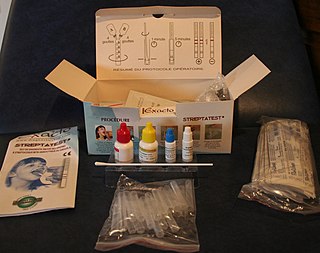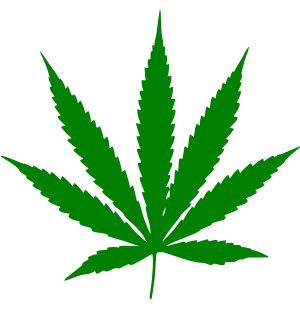Related Research Articles
Benedict's reagent is a chemical reagent and complex mixture of sodium carbonate, sodium citrate and copper(II) sulfate pentahydrate. It is often used in place of Fehling's solution to detect the presence of reducing sugars. The presence of other reducing substances also gives a positive result. Such tests that use this reagent are called the Benedict's tests. A positive test with Benedict's reagent is shown by a color change from clear blue to brick-red with a precipitate.
Marquis reagent is used as a simple spot-test to presumptively identify alkaloids as well as other compounds. It is composed of a mixture of formaldehyde and concentrated sulfuric acid, which is dripped onto the substance being tested. The United States Department of Justice method for producing the reagent is the addition of 100 mL of concentrated (95–98%) sulfuric acid to 5 mL of 40% formaldehyde. Different compounds produce different color reactions. Methanol may be added to slow down the reaction process to allow better observation of the colour change.
A drug test is a technical analysis of a biological specimen, for example urine, hair, blood, breath, sweat, and/or oral fluid/saliva—to determine the presence or absence of specified parent drugs or their metabolites. Major applications of drug testing include detection of the presence of performance enhancing steroids in sport, employers and parole/probation officers screening for drugs prohibited by law and police officers testing for the presence and concentration of alcohol (ethanol) in the blood commonly referred to as BAC. BAC tests are typically administered via a breathalyzer while urinalysis is used for the vast majority of drug testing in sports and the workplace. Numerous other methods with varying degrees of accuracy, sensitivity, and detection periods exist.

A detection dog or sniffer dog is a dog that is trained to use its senses to detect substances such as explosives, illegal drugs, wildlife scat, currency, blood, and contraband electronics such as illicit mobile phones. The sense most used by detection dogs is smell. The smell from the detection dogs are more enhanced than the average dog. They are trained to have this great sense of smell. Hunting dogs that search for game, and search dogs that work to find missing humans are generally not considered detection dogs. There is some overlap, as in the case of cadaver dogs, trained to search for human remains. A police dog is essentially a detection dog that is used as a resource for police in specific scenarios such as conducting drug raids, finding missing criminals, and locating stashed currency.
![Chemical ionization Ionization technique used in mass [[spectroscopy]]](https://upload.wikimedia.org/wikipedia/commons/thumb/7/7b/Chemical_Ionization.png/320px-Chemical_Ionization.png)
Chemical ionization (CI) is a soft ionization technique used in mass spectrometry. This was first introduced by Burnaby Munson and Frank H. Field in 1966. This technique is a branch of gaseous ion-molecule chemistry. Reagent gas molecules are ionized by electron ionization, which subsequently react with analyte molecules in the gas phase in order to achieve ionization. Negative chemical ionization (NCI), charge-exchange chemical ionization and atmospheric-pressure chemical ionization (APCI) are some of the common variations of this technique. CI has several important applications in identification, structure elucidation and quantitation of organic compounds. Beside the applications in analytical chemistry, the usefulness in chemical ionization extends toward biochemical, biological and medicinal fields as well.

The Kastle–Meyer test is a presumptive blood test, first described in 1903, in which the chemical indicator phenolphthalein is used to detect the possible presence of hemoglobin. It relies on the peroxidase-like activity of hemoglobin in blood to catalyze the oxidation of phenolphthalin into phenolphthalein, which is visible as a bright pink color. The Kastle–Meyer test is a form of catalytic blood test, one of the two main classes of forensic tests commonly employed by crime labs in the chemical identification of blood. The other class of tests used for this purpose are microcrystal tests, such as the Teichmann crystal test and the Takayama crystal test.

The DrugWipe is a test used to wipe surfaces for traces of drug residue. It may also be used for sweat or saliva testing of individuals. Law enforcement at the roadside can quickly screen suspected drivers of being under the influence of an illegal drug by using the DrugWipe. DrugWipe was named a finalist in the 2011 Cygnus Law Enforcement Group Innovation Awards competition. The DrugWipe 6s test was entered under the category of 'Traffic Enforcement'.
In chemistry, a precursor is a compound that participates in a chemical reaction that produces another compound.
Many urban legends and misconceptions about drugs have been created and circulated among young people and the general public, with varying degrees of veracity. These are commonly repeated by organizations which oppose all classified drug use, often causing the true effects and dangers of drugs to be misunderstood and less scrutinized. The most common subjects of such false beliefs are LSD, cannabis, and MDMA. These misconceptions include misinformation about adulterants or other black market issues, as well as alleged effects of the pure substances.

Autonomous Detection Systems (ADS), also called biohazard detection systems, or autonomous pathogen detection systems are designed to monitor air in an environment and to detect the presence of airborne chemicals, toxins, pathogens, or other biological agents capable of causing human illness or death. These systems monitor the air continuously and send real-time alerts to appropriate authorities in the event of an act of bioterrorism or biological warfare.
The Duquenois reagent is used in the Rapid Modified Duquenois–Levine test, is an established screening test for the presence of cannabis. The test was initially developed in the 1930s by the French Medical Biochemist, Pierre Duquénois (1904–1986), and was adopted in the 1950s by the United Nations as the preferred test for cannabis, and originally claimed to be specific to cannabis. After several modifications, it became known as the Duquenois–Levine test. However, in the 1960s and 70s various studies showed that the test was not specific to cannabis. In 1973 the Supreme Court of Wisconsin ruled the D–L test insufficient evidence for demonstrating that a substance was cannabis, specifically noting that the D–L tests used "are not exclusive or specific for marijuana."

Cobalt(II) thiocyanate is an inorganic compound with the formula Co(SCN)2. It is a layered coordination complex and its trihydrate Co(SCN)2(H2O)3 is used in the cobalt thiocyanate test (or Scott test) for detecting cocaine. The test has been responsible for widespread false positives and false convictions.
Materials MASINT is one of the six major disciplines generally accepted to make up the field of Measurement and Signature Intelligence (MASINT), with due regard that the MASINT subdisciplines may overlap, and MASINT, in turn, is complementary to more traditional intelligence collection and analysis disciplines such as SIGINT and IMINT. MASINT encompasses intelligence gathering activities that bring together disparate elements that do not fit within the definitions of Signals Intelligence (SIGINT), Imagery Intelligence (IMINT), or Human Intelligence (HUMINT).

The rapid strep test (RST) is a rapid antigen detection test (RADT) that is widely used in clinics to assist in the diagnosis of bacterial pharyngitis caused by group A streptococci (GAS), sometimes termed strep throat. There are currently several types of rapid strep test in use, each employing a distinct technology. However, they all work by detecting the presence of GAS in the throat of a person by responding to GAS-specific antigens on a throat swab.

A urine test strip or dipstick is a basic diagnostic tool used to determine pathological changes in a patient's urine in standard urinalysis.
Ehrlich's reagent or Ehrlich reagent is a reagent that contains p-dimethylaminobenzaldehyde (DMAB) and thus can act as an indicator to presumptively identify indoles and urobilinogen. Several Ehrlich tests use the reagent in a medical test; some are drug tests and others contribute to diagnosis of various diseases or adverse drug reactions. A very common Ehrlich test is a simple spot test to identify possible psychoactive compounds such as tryptamines and ergoloids. The reagent will also give a positive result for opium, because of the presence of tryptophan in natural opium. It is named after Nobel Prize winner Paul Ehrlich who used it to distinguish typhoid from simple diarrhoea.

The term Environmental persistent pharmaceutical pollutants (EPPP) was first suggested in the nomination in 2010 of pharmaceuticals and environment as an emerging issue in a Strategic Approach to International Chemicals Management (SAICM) by the International Society of Doctors for the Environment (ISDE). The occurring problems from EPPPs are in parallel explained under environmental impact of pharmaceuticals and personal care products (PPCP). The European Union summarizes pharmaceutical residues with the potential of contamination of water and soil together with other micropollutants under “priority substances”.
The Zwikker reagent is used as a simple spot-test to presumptively identify barbiturates. It is composed of a mixture of two solutions. Part A is 0.5 g of copper (II) sulfate in 100 ml of distilled water. Part B consists of 5% pyridine (v/v) in chloroform. One drop of each is added to the substance to be tested and any change in colour is observed.

Cannabis drug testing describes various drug test methodologies for the use of cannabis in medicine, sport, and law. Cannabis use is highly detectable and can be detected by urinalysis, hair analysis, as well as saliva tests for days or weeks.
The Gallic acid reagent is used as a simple spot-test to presumptively identify drug precursor chemicals. It is composed of a mixture of gallic acid and concentrated sulfuric acid.
References
- 1 2 3 Heather Smith (2007-06-17). "County schools have new weapon to fight drugs".
- ↑ Mistral Group. "Drug Detection". Archived from the original on 2007-08-14.
- ↑ "Program Overview". Archived from the original on 2007-06-07.